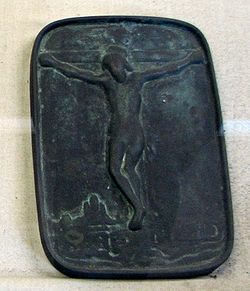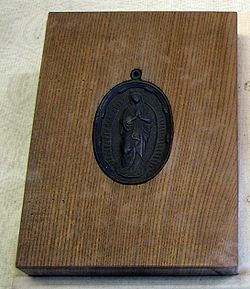
Fumie
Encyclopedia


Jesus
Jesus of Nazareth , commonly referred to as Jesus Christ or simply as Jesus or Christ, is the central figure of Christianity...
or Mary
Mary (mother of Jesus)
Mary , commonly referred to as "Saint Mary", "Mother Mary", the "Virgin Mary", the "Blessed Virgin Mary", or "Mary, Mother of God", was a Jewish woman of Nazareth in Galilee...
upon which the religious authorities of the Tokugawa shogunate
Tokugawa shogunate
The Tokugawa shogunate, also known as the and the , was a feudal regime of Japan established by Tokugawa Ieyasu and ruled by the shoguns of the Tokugawa family. This period is known as the Edo period and gets its name from the capital city, Edo, which is now called Tokyo, after the name was...
of Japan
Japan
Japan is an island nation in East Asia. Located in the Pacific Ocean, it lies to the east of the Sea of Japan, China, North Korea, South Korea and Russia, stretching from the Sea of Okhotsk in the north to the East China Sea and Taiwan in the south...
required suspected Christians
Christianity
Christianity is a monotheistic religion based on the life and teachings of Jesus as presented in canonical gospels and other New Testament writings...
to step in order to prove that they were not members of that outlawed religion
Religion
Religion is a collection of cultural systems, belief systems, and worldviews that establishes symbols that relate humanity to spirituality and, sometimes, to moral values. Many religions have narratives, symbols, traditions and sacred histories that are intended to give meaning to life or to...
. The use of fumi-e began with the persecution of Christians in Nagasaki in 1629. Their use was officially abandoned for ports open to foreigners on April 13, 1856, but some remained in use until Christian teaching was placed under formal protection during the Meiji period
Meiji period
The , also known as the Meiji era, is a Japanese era which extended from September 1868 through July 1912. This period represents the first half of the Empire of Japan.- Meiji Restoration and the emperor :...
. The objects were also known as e-ita or ita-e, while the forced test was called e-fumi. The "ceremony of e-fumi, of trampling on images, was well enough reported in Europe already by the early eighteenth century to have left a mark on works of imaginative literature like Jonathan Swift
Jonathan Swift
Jonathan Swift was an Irish satirist, essayist, political pamphleteer , poet and cleric who became Dean of St...
's Gulliver's Travels
Gulliver's Travels
Travels into Several Remote Nations of the World, in Four Parts. By Lemuel Gulliver, First a Surgeon, and then a Captain of Several Ships, better known simply as Gulliver's Travels , is a novel by Anglo-Irish writer and clergyman Jonathan Swift that is both a satire on human nature and a parody of...
, Oliver Goldsmith
Oliver Goldsmith
Oliver Goldsmith was an Irish writer, poet and physician known for his novel The Vicar of Wakefield , his pastoral poem The Deserted Village , and his plays The Good-Natur'd Man and She Stoops to Conquer...
's The Citizen of the World, and Voltaire
Voltaire
François-Marie Arouet , better known by the pen name Voltaire , was a French Enlightenment writer, historian and philosopher famous for his wit and for his advocacy of civil liberties, including freedom of religion, free trade and separation of church and state...
's Candide
Candide
Candide, ou l'Optimisme is a French satire first published in 1759 by Voltaire, a philosopher of the Age of Enlightenment. The novella has been widely translated, with English versions titled Candide: or, All for the Best ; Candide: or, The Optimist ; and Candide: or, Optimism...
," according to Prof. Michael North in Artistic and Cultural Exchanges Between Europe and Asia, 1400-1900. In modern Japanese literature, treading on the fumi-e is a pivotal plot element of the novel Silence
Silence (novel)
is a 1966 novel of historical fiction by Japanese author Shusaku Endo. It is the story of a Jesuit missionary sent to seventeenth century Japan, who endured persecution in the time of Kakure Kirishitan that followed the defeat of the Shimabara Rebellion...
by Shusaku Endo
Shusaku Endo
Shūsaku Endō was a 20th-century Japanese author who wrote from the unusual perspective of being both Japanese and Catholic...
.
The Japanese government used fumi-e to reveal practicing Catholics and sympathizers. Fumi-e were pictures of the Virgin Mary and Christ
Christ
Christ is the English term for the Greek meaning "the anointed one". It is a translation of the Hebrew , usually transliterated into English as Messiah or Mashiach...
. Government officials made everybody trample on these pictures. People reluctant to step on the pictures were identified as Catholics and were sent to Nagasaki. The policy of the Edo government was to turn them from their faith, Catholicism. However, if the Catholics refused to change their religion, they were torture
Torture
Torture is the act of inflicting severe pain as a means of punishment, revenge, forcing information or a confession, or simply as an act of cruelty. Throughout history, torture has often been used as a method of political re-education, interrogation, punishment, and coercion...
d. But as many of them still refused to abandon their faith, they were killed by the government. Executions sometimes took place at Nagasaki's Mount Unzen
Mount Unzen
is an active volcanic group of several overlapping stratovolcanoes, near the city of Shimabara, Nagasaki Prefecture, on the island of Kyūshū, Japan’s southernmost main island....
, where some were dumped into the volcano.
Execution for Christianity was unofficially abandoned by the Tokugawa Shogunate in 1805.
Fumi-e were usually carved out of stone, but others were painted and some were wooden block prints. Many, if not all, of these works were made with care, and they reflected the high artistic standards of the Edo period. There are very few existing fumi-e, as most were simply thrown away or recycled into other uses. Some surviving examples were displayed by the Smithsonian in their 2007 exhibition "Encompassing the Globe: Portugal and the World in the 16th and 17th Centuries."
Many theologians have tried to contemplate the role of the fumi-e to Japanese Christians, some seeing the treading of the fumi-e as a sign of the love and forgiveness of Jesus Christ.

